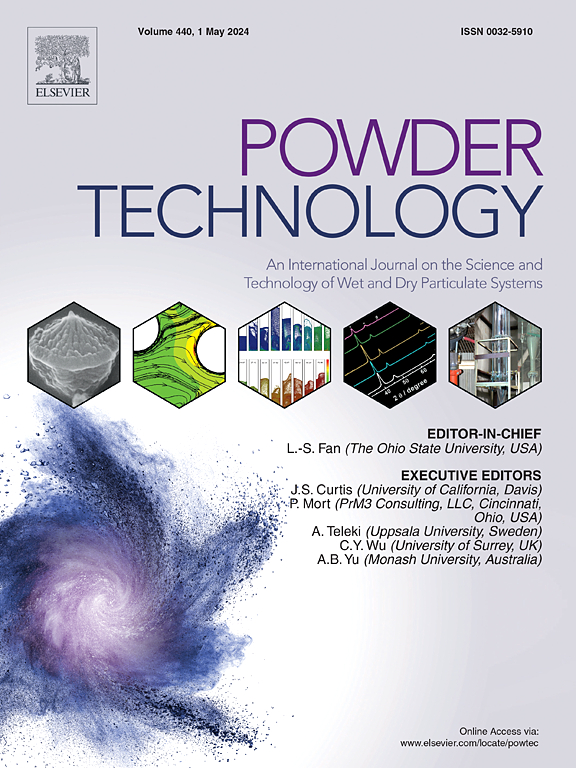Performance enhancement of cyclone deoiling for oily sludge based on BP neural network model and genetic algorithm
IF 4.5
2区 工程技术
Q2 ENGINEERING, CHEMICAL
引用次数: 0
Abstract
Performance enhancement in cyclone deoiling systems plays a critical role in improving oily sludge treatment efficiency and cutting energy consumption. This paper delved into the mechanism of cyclone deoiling, constructed Back Propagation (BP) neural networks to analyze the predictive performance of average shear rate and pressure drop, and achieved collaborative optimization of the cyclone structure by using the Nondominated Sorting Genetic Algorithm II (NSGA-II), aiming to balance deoiling efficiency and energy consumption. Through a combination of Computational Fluid Dynamics (CFD) simulations and experimental validation, the study systematically revealed the changes in particle dynamics and properties of oil-based mud (OBM) cuttings before and after optimization. The results demonstrated that the BP model outperformed the response surface model, Support Vector Machine (SVM), and Random Forest (RF) methods in predicting the average shear rate and pressure drop. The optimal cyclone structure corresponded to an average shear rate of 3111.23 s−1 (an increase of 24.62 %) and a pressure drop of 992.54 Pa (an increase of 5.64 %), with prediction errors reduced to 0.80 % and 0.56 %, respectively. CFD simulations showed that the radial coupling centrifugal separation factor increased to 3.49 times that before optimization, and the pressure drop increased by 5.05 %. In the experiment, at an inlet velocity of 19 m/s, the oil content dropped to 0.49 %, the deoiling efficiency increased to 95.07 %, and the pressure drop increased by only 66.67 Pa, which was highly consistent with the predicted and simulated results. This study's intelligent optimization method provides an efficient, low-energy solution for oily sludge treatment, supporting sustainable oilfield development.

基于BP神经网络模型和遗传算法的油泥旋风除油性能提升
提高旋风除油系统的性能对提高含油污泥处理效率和降低能耗具有重要作用。本文深入研究了旋流器脱油机理,构建BP神经网络,分析了平均剪切速率和压降的预测性能,并利用NSGA-II非主导排序遗传算法实现了旋流器结构的协同优化,以平衡脱油效率和能耗。通过计算流体动力学(CFD)模拟与实验验证相结合,系统揭示了优化前后油基泥浆(OBM)岩屑颗粒动力学和性质的变化。结果表明,BP模型在预测平均剪切速率和压降方面优于响应面模型、支持向量机(SVM)和随机森林(RF)方法。最优气旋结构对应的平均剪切速率为3111.23 s−1(增加24.62%),压降为992.54 Pa(增加5.64%),预测误差分别降低至0.80%和0.56%。CFD模拟结果表明,径向耦合离心分离系数提高到优化前的3.49倍,压降提高了5.05%。实验中,在进口速度为19 m/s时,含油量下降到0.49%,脱油效率提高到95.07%,压降仅增加66.67 Pa,与预测和模拟结果高度一致。本研究的智能优化方法为含油污泥处理提供了一种高效、低能耗的解决方案,支持油田的可持续发展。
本文章由计算机程序翻译,如有差异,请以英文原文为准。
求助全文
约1分钟内获得全文
求助全文
来源期刊

Powder Technology
工程技术-工程:化工
CiteScore
9.90
自引率
15.40%
发文量
1047
审稿时长
46 days
期刊介绍:
Powder Technology is an International Journal on the Science and Technology of Wet and Dry Particulate Systems. Powder Technology publishes papers on all aspects of the formation of particles and their characterisation and on the study of systems containing particulate solids. No limitation is imposed on the size of the particles, which may range from nanometre scale, as in pigments or aerosols, to that of mined or quarried materials. The following list of topics is not intended to be comprehensive, but rather to indicate typical subjects which fall within the scope of the journal's interests:
Formation and synthesis of particles by precipitation and other methods.
Modification of particles by agglomeration, coating, comminution and attrition.
Characterisation of the size, shape, surface area, pore structure and strength of particles and agglomerates (including the origins and effects of inter particle forces).
Packing, failure, flow and permeability of assemblies of particles.
Particle-particle interactions and suspension rheology.
Handling and processing operations such as slurry flow, fluidization, pneumatic conveying.
Interactions between particles and their environment, including delivery of particulate products to the body.
Applications of particle technology in production of pharmaceuticals, chemicals, foods, pigments, structural, and functional materials and in environmental and energy related matters.
For materials-oriented contributions we are looking for articles revealing the effect of particle/powder characteristics (size, morphology and composition, in that order) on material performance or functionality and, ideally, comparison to any industrial standard.
 求助内容:
求助内容: 应助结果提醒方式:
应助结果提醒方式:


